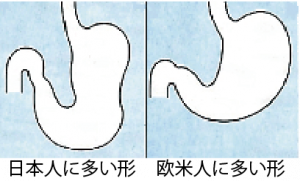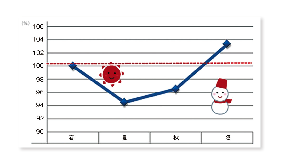[What is the constitution of Japanese people? ]
―First of all, please tell us about the characteristics of the constitution that Japanese people have.
Strong Points
HDL compared to Caucasians10% less likely to develop arteriosclerosis
First of all, the advantage is that it is less likely to become arteriosclerosis.
Recently, the number of myocardial infarctions and cerebral infarctions caused by arteriosclerosis is increasing in Japan as well. .There are probably two reasons for this.
One is that the Japanese genetically have more so-called good cholesterol (HDL).
For example, compared to white Americans,10There is a lot of HDL about %.
10You may think that % is a small difference, but it is a difference that can be said to be decisive for the body.
The other is that the blood concentration of EPA (eicosapentaenoic acid) and DHA (docosahexaenoic acid) contained in fish is high. EPA and DHA have the effect of preventing arteriosclerosis.
Japanese people have traditionally eaten a lot of fish, so EPA and DHA are dissolved in their blood.
Japanese people are less prone to arteriosclerosis due to genetically high levels of HDL and the fact that they eat a lot of fish in their diet.
Even if the level of bad cholesterol (LDL) is as high in Japanese as in Caucasian Americans, arteriosclerosis progresses more in Americans.
Clean intestinal environment with lots of good bacteria
Then, the intestinal environment is good.
Led by Waseda University,12There is a study that examined the types and numbers of intestinal bacteria in about XNUMX people from several countries.
Looking at the contents announced last year, it was the Japanese who had the cleanest intestinal environment.It was said that there were many good bacteria such as bifidobacteria and few bad bacteria.
In addition, there are many bacteria in the intestines of Japanese people that are useful for extracting energy from carbohydrates such as rice without waste.It seems that this fungus was very small in other countries.It means that the food you eat creates the intestinal environment.
The researchers who conducted the research point out that the fact that the intestinal environment is clean may be behind the long life expectancy and low obesity rate of Japanese people.
-vice versa,12Which of the countries did not do so well?
Venezuela, which still lacks a sufficient sanitation environment, is the United States in developed countries, and China, which has developed in recent years.
The Chinese genetically overlap with the Japanese, who are also Asian, and I think there are some similarities in their eating habits, but unlike the Japanese, they have a lot of bad bacteria, and the same is true for the Americans. .
Stomach shape suitable for eating rice
3The first is that not only the intestines but also the stomach have characteristics, and the shape of the stomach is different in the first place.
It is said that the Japanese stomach has a shape suitable for eating rice.
Carbohydrates, including rice, cannot be extracted as energy unless they are sufficiently stirred in the stomach and sent to the intestine in a crushed state.
Therefore, most Japanese people have stomachs that are curved like fish hooks, and because they are long, it is difficult for them to flow backwards. .
On the other hand, people in Europe and the United States mainly eat meat, and the main stage of digestion and absorption of fat and protein is the small intestine.
For that reason, it is better to send food to the intestines as soon as possible, so it is in a shape that allows it to leave the stomach smoothly. (See Figure XNUMX)
The Japanese said that they have intestinal bacteria that are suitable for extracting energy from carbohydrates.
[Fig. XNUMX] Japanese and Westerners have different stomach shapes
Of course, Japanese people can eat meat, but fat in particular takes longer to digest than Westerners, so it can cause a heavy stomach or constipation because it stays in the intestines for a long time. is likely to occur.
Very strong bones and very little osteoporosis
Also, we must not forget that the Japanese have very strong bones.Less osteoporosis.
It is often said that Japanese people consume only half the amount of calcium that Americans do, so we should take more calcium. There are many.
In addition to osteoporosis, it is known that Asians, including Japanese, account for only half to at most two-thirds of those in Europe and the United States in terms of the percentage of people who have broken bones in their limbs due to injuries.
XNUMX times more soy than Americans
It is said that there are probably two reasons why bones are so strong.
Osteoporosis is strongly influenced by genetics, so if your mother had osteoporosis, you have a high chance of getting osteoporosis.Therefore, it is thought that there are probably many Japanese people who have a gene that makes it difficult to fracture bones.
Osteoporosis is a problem because there are more elderly people now, and it may be thought that people in the past died before they developed osteoporosis.
Another difference is where you get your calcium from.
People in Europe and the United States basically think that milk is the source of calcium when it comes to calcium.
However, in Japan, there was no custom of drinking milk from the beginning, and it was taken from vegetables, seaweed, soybeans, and small fish.
In particular, soybeans not only contain calcium, but have been confirmed to have the effect of preventing calcium from escaping from bones.
Japanese people consume XNUMX times more soybeans than Americans, and there is an overwhelming difference in intake.
In the United States, with the exception of indigenous people, white people eat only health foods made from soy protein at most.
Basal metabolism that drops in summer and rises in winter
[Figure 2] The basal metabolic rate of Japanese people varies according to the season
One last thing.A very big feature of the Japanese is that the basal metabolism fluctuates throughout the year.
As you can see from Figure XNUMX, the basal metabolic rate of Japanese people is XNUMX in spring, and it drops in summer, and rises sharply in autumn and winter.
However, in Europe and the United States, there is no change, and it is always high throughout the year.
The reason why your basal metabolism fluctuates is because it is cold in winter, so your body needs to burn more and more energy to maintain your body temperature.That's why your basal metabolism goes up.
On the other hand, summer is hot, so you can easily maintain your body temperature.Therefore, there is no need to burn energy, and the basal metabolism is lowered.
If your basal metabolism slows down, you will need fewer calories, so you will lose your appetite and exercise less.That's why I want to take a nap.
When I do that, people sometimes say, "Isn't that summer heat exhaustion?"
It is said that you should eat well because you are tired of the summer, but if you force yourself to eat in such a state, it will put a lot of strain on your stomach and intestines.
Especially for the elderly, the fluctuation is large.
Also, if you eat high-calorie foods with a low basal metabolism, you will gain weight.
Especially in Japan, summers are hot and humid unlike in Europe and the United States, so it makes sense to spend summers using as little energy as possible.
This tendency is especially strong in the elderly, and the basal metabolism is greatly reduced.That's why I sometimes hear conversations like, "Recently, my grandma's diet has gotten thinner. Maybe she's getting old." That's it.
However, vitamins and minerals cannot be stored, so if you take them as much as possible every day, there is no need to get nervous and think, "I have to eat."
Why traditional Japanese food is suitable for Japanese people (XNUMX)
-----------------------------------------------------------------------------------
Masako Okuda
Physician, medical examiner.medical doctor.He graduated from Kyoto University Graduate School of Medicine.Over the past XNUMX years, he has provided medical checkups and medical examinations for XNUMX people at a large-scale health checkup center, and has also translated medical literature and books.His books include “Japanese constitution so different from Westerners” (Kodansha Bluebacks), “It is scary to miss the “B judgment” of health check” (Seishun Shinsho Intelligence).